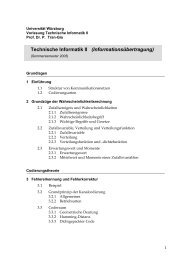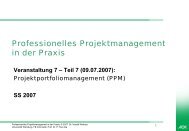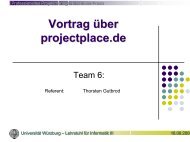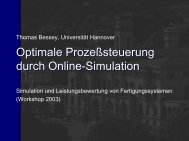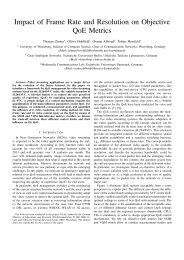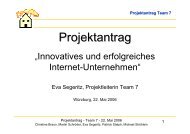Table 4: Received packets <strong>in</strong> <strong>UMTS</strong> downl<strong>in</strong>k scenariopayload number mean PIT std. PIT3 B 6 9.46 s 4.49 s21 B 14 1.73 s 3.58 s108 B 817 61.32 ms 16.00 ms112 B 16 3.20 s 45.02 ms4.3 Network Utility FunctionWe <strong>in</strong>vestigate the impact <strong>of</strong> the loss ratio on the NUF, i.e. on the PESQ, by study<strong>in</strong>g thebottleneck LAN scenario described <strong>in</strong> Section 4.1 <strong>and</strong> us<strong>in</strong>g ∆T = 150 ms. By reduc<strong>in</strong>g thespeed <strong>of</strong> the bottleneck l<strong>in</strong>k beyond the need <strong>of</strong> the <strong>Skype</strong> connection, we provoke loss whose<strong>in</strong>tensity is roughly given by the miss<strong>in</strong>g capacity share. Figure 12 shows a scatter plot <strong>of</strong> PESQversus the loss ratio l. Even though the PESQ values are highly vary<strong>in</strong>g even for similar lossratios, a l<strong>in</strong>ear trend can be observed <strong>in</strong> Figure 12 as l <strong>in</strong>creases (as assumed <strong>in</strong> [4]). Simpleregression analysis for l ≤ 0.2 (i.e. a l<strong>in</strong>k speed <strong>of</strong> at least 24 kbps) leads to U m ≃ 1 − 1.5 l.Interest<strong>in</strong>gly enough, the change <strong>in</strong> the relative st<strong>and</strong>ard deviation jumps from σ ≃ 0 to σ ≃ 0.3as soon as loss due to overload occurs, while the damp<strong>in</strong>g <strong>of</strong> the PESQ as a function <strong>of</strong> theoverload <strong>in</strong>tensity is sufficiently described by the m-utility function alone. This behavior isdifferent from the one observed <strong>in</strong> [4], where the sources <strong>of</strong> loss <strong>and</strong> delay variations were<strong>in</strong>dependent <strong>of</strong> each other. On the other h<strong>and</strong>, there is an impact on the PESQ which is due to thefact that a network is used, which is captured by the n-utility function U n = 2.90/3.93 ≃ 0.74(cf. Sect. 3). Thus, the complete NUF <strong>in</strong> the bottleneck LAN case reads U Netw ≃ U n · U m <strong>and</strong>U s = 1.In the <strong>UMTS</strong> scenario (cf. Section 4.2), no significant loss has been observed, which meansU m ≃ 1. However, as seen from the scatter plot shown <strong>in</strong> Figure 13, upl<strong>in</strong>k <strong>and</strong> downl<strong>in</strong>kPESQ3.532.516 kbps24 kbps28 kbps32 kbpsPESQ2.82.62.4upl<strong>in</strong>kdownl<strong>in</strong>k22.21.50 0.2 0.4packet loss ratio20 0.02 0.04 0.06 0.08 0.1σ = (s − s ) / s rcvd sent sentFigure 12: Packet loss probability l vs. PESQ forthe bottleneck LAN scenarioFigure 13: σ = (s rcvd − s sent ) /s sent vs. PESQfor the <strong>UMTS</strong> scenario12
experience different <strong>in</strong>tensities <strong>of</strong> throughput variations [8], which allows us to take approximateit as follows: U s ≃ 1 − 2σ (0 ≤ σ < 0.1). As discussed <strong>in</strong> Section 4.2, the orig<strong>in</strong> <strong>of</strong> the PESQvalues is not the same as <strong>in</strong> the bottleneck LAN case (2.49 for σ = 0 <strong>in</strong>stead <strong>of</strong> 2.90, cf. Fig. 13with 12). We can capture this effect, caused by the mobile network <strong>and</strong> <strong>Skype</strong>’s selection <strong>of</strong> anappropriate codec, by modify<strong>in</strong>g the value <strong>of</strong> the n-utility function to U n = 2.49/3.93 ≃ 0.63.Summariz<strong>in</strong>g, the NUF as a whole reads U Netw = U n · U m · U s .5 Conclusion <strong>and</strong> Outlook<strong>VoIP</strong> telephony has become a strong competitor to exist<strong>in</strong>g telephone networks. In this study,the user perceived quality <strong>of</strong> <strong>Skype</strong> calls over <strong>UMTS</strong> was measured <strong>and</strong> analyzed <strong>in</strong> terms <strong>of</strong>PESQ values <strong>and</strong> network-based <strong>in</strong>fluence factors, like packet loss, throughput, <strong>and</strong> jitter.We emulated the rate control mechanisms <strong>in</strong> <strong>UMTS</strong> by restrict<strong>in</strong>g the l<strong>in</strong>k b<strong>and</strong>width with atraffic-shap<strong>in</strong>g router. In this case, <strong>Skype</strong> does not react to packet loss, as e.g. by <strong>in</strong>creas<strong>in</strong>gthe sender throughput, but constantly sends audio data with roughly 25 kbps. The occurr<strong>in</strong>gpacket loss degrades the PESQ value. For bottleneck l<strong>in</strong>ks below 32 kbps, a l<strong>in</strong>ear dependency<strong>of</strong> the PESQ value on the loss was discovered, while it varies around 2.9 for l<strong>in</strong>ks <strong>of</strong> higherb<strong>and</strong>width. The measurements <strong>in</strong> a public <strong>UMTS</strong> networks revealed that the capacity <strong>of</strong>fered by<strong>UMTS</strong> is sufficient to make mobile <strong>VoIP</strong> calls possible. However, due to network jitter <strong>and</strong> theuse <strong>of</strong> a different codec by <strong>Skype</strong>, the PESQ values are worse than those <strong>in</strong> the emulation <strong>of</strong> thebottleneck <strong>in</strong> a LAN environment. The used <strong>UMTS</strong> card sends <strong>and</strong> receives packets at discretetime <strong>in</strong>stants <strong>in</strong> multiples <strong>of</strong> 1 ms. The packet <strong>in</strong>terarrival times on the downl<strong>in</strong>k are multiples<strong>of</strong> 20 ms, which corresponds to a common transport time <strong>in</strong>terval TTI <strong>in</strong> <strong>UMTS</strong>.F<strong>in</strong>ally, we showed that the concept <strong>of</strong> the Network Utility Function can be applied to describethe impact <strong>of</strong> the network on the PESQ. Thereby the network-based <strong>in</strong>fluence factors aresufficient to approximate the PESQ values. The next step will be to <strong>in</strong>vestigate the dependencybetween loss <strong>and</strong> chang<strong>in</strong>g traffic characteristics <strong>and</strong> the correspond<strong>in</strong>g impact on the PESQ <strong>and</strong>the utility functions.AcknowledgementsThe authors would like to thank Melanie Brotzeller for perform<strong>in</strong>g the measurements, programm<strong>in</strong>gall scripts, <strong>and</strong> the fruitful discussions; Thomas Z<strong>in</strong>ner, <strong>and</strong> Frank Bennewitz for help<strong>in</strong>gdur<strong>in</strong>g the measurements; Stefan Chevul for the much appreciated <strong>in</strong>put dur<strong>in</strong>g the course <strong>of</strong>this work; <strong>and</strong> Frank-Uwe Andersen <strong>and</strong> the Siemens AG for support<strong>in</strong>g the measurements.13





